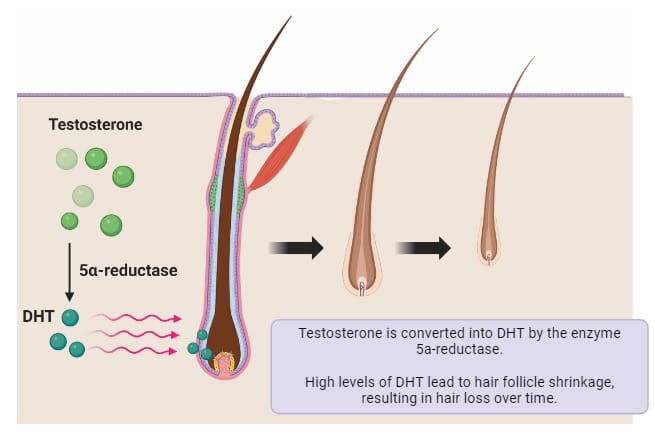Have you noticed more hair loss after dyeing your hair? The ingredients in some dyes can be hazardous to hair, and knowing what is safe to use and how to use it is crucial for enjoying hair dye while maintaining a healthy scalp and hair.
In this article, we will guide you through the different types of hair dyes and provide safe hair colouring options.
Can Hair Dye Cause Hair Loss?
Yes, overuse of hair dye or poor hair care practices can cause hair loss due to the harsh chemicals mixed in most permanent hair dye formulas.
Oxidative (permanent) dyes often contain ingredients such as ammonia, hydrogen peroxide, and paraphenylenediamine (PPD).
Ammonia breaks the hair cuticle in such a way that the dye and peroxide can enter the shaft of the hair, which is great for colour, but can also make hair porous, weakened over time and easy to break.

Over-processing (either by colouring too frequently or high-lift formulations) causes an ongoing cycle of damage that may lead to hair breakage and eventual hair loss.
It is estimated that 33 percent of women aged over 18 and over 10 percent of men aged over 40 in Europe and the United States colour their hair regularly.
This emphasises the importance of balancing hair care with cosmetic preferences to prevent excessive damage. To maintain healthy hair, it is recommended to use a less harsh formula that are gentler on your hair and limit the use of permanent dyes.
What causes hair to fall out after using dye?
The following are essential reasons why hair falls out after dyeing:
- Strong Chemicals: The strong chemicals used in hair dye, such as ammonia and hydrogen peroxide, can make hair fragile. Some individuals find these chemicals to be irritating to the scalp and even cause hair loss.
- Excessive Application: Excessive application of hair dye or waiting too long after dyeing your hair to rinse it out can result in brittle and breakable strands. In a vicious cycle, dyeing already damaged or weakened hair may exacerbate hair loss.
Will hair loss due to hair dye grow back?
Hair loss caused by applying hair dye to your hair can be restored if you stop dyeing your hair and follow good hair care practices.
As hair dyes do not actively slow down your hair growth cycle, your hair can grow back. Maintaining good hair health is crucial for preventing hair loss and promoting the growth of new hair strands.
What ingredients in hair dye cause hair loss?
- Hydrogen Peroxide: Hydrogen peroxide is useful in stripping melanin (natural pigment) from the hair to produce a lighter colour.
- Ammonia: Ammonia helps to ‘open’ the hair shaft, allowing dyes to penetrate more deeply, resulting in longer-lasting colour. Because of their dramatic effect in achieving colour change, ammonia-based dyes are common.
Using these chemicals is very effective in changing the colour of hair, but over time, it can cause the hair to become dehydrated and fragile.

Which hair dyes do not cause hair loss?
For gentler dyeing options, hair dyes that do not contain ammonia and high concentrations of hydrogen peroxide are preferable in the long term.
Semi-permanent dyes, oil-based formulas, and vegetable-based options, such as henna, are also gentler alternatives. That being said, these dyes are less long-lasting and may not be as dramatic.
Semi-permanent dyes and colour rinses are suitable when the colour change is short-term. They are less harmful but also fade fast and need to be applied regularly.
Natural dyes, such as henna, can be beneficial and strengthen hair; however, they often lack colour versatility.
How Often Is It Safe to Dye Hair?
To keep your colour-treated hair as healthy as possible, it’s recommended that you don’t dye or bleach your hair more than once every 6-8 weeks.
Like with everything, moderation is key when it comes to safely dyeing your hair. This is because hair can typically withstand the chemicals used in hair dye in small doses.
A single treatment is unlikely to cause severe hair breakage or loss.
To maintain your new hair colour, you’ll need to use hair dye regularly. As new hair starts to grow through, you’ll find that you may need to do touch-ups to avoid discoloured roots.
Preventing Hair Loss Due to Hair Dye
- Reduce Use: The best way to minimise the damage is to ensure that dyes containing ammonia and high concentrations of hydrogen peroxide are used as infrequently as possible.
- Deep Condition: Deep conditioning treatments can restore moisture to your locks and make hair stronger.
- Gentle Hair Care: Reduce the use of heat styling tools, products, and aggressive brushing and tight hairstyles to prevent hair breakage and scalp stress.
Other Causes of Hair Loss
Besides dyeing, it is essential to embrace healthy hair care behaviours to prevent and slow hair loss. Check out our article for more tips on how to prevent hair loss.
- Nutritional Deficiencies: Poor nutrition and low levels of vitamins and minerals, such as Vitamin D, Iron, B12, Folate, and Zinc, can lead to poor hair growth and eventual loss. To combat this, eat a well-balanced diet and consider taking supplements to help boost your levels.
- Genetics: If you have a family history of hair loss, those genes may have been passed down to you. This is unavoidable, but can still be treated.
- Medical Conditions: Certain medical conditions, such as cancer, require chemotherapy agents to treat. A side effect of certain drugs is hair loss.
There are treatment options available for many causes of hair loss, including medications such as Finasteride and Minoxidil, as well as more permanent surgical options.
Conclusion
Hair dyes, perms, straighteners and relaxers are common hair products that many individuals use daily to style their hair and express themselves.
While maintaining your hair can boost confidence, it’s also essential to nurture its health and growth by incorporating gentle hair care practices and using moisturising and strengthening treatments.
Overall health, well-being, and hair health are all interconnected. If you are experiencing worsening hair loss and want a tailored guide on what options are available to you, get in touch with our friendly team The Treatment Rooms London to start your hair restoration journey towards fuller, thicker locks.
The Treatment Rooms London is an award-winning UK hair transplant clinic, founded by leading hair transplant surgeons, Dr Fernando and Dr Vara, with state-of-the-art facilities in London, and a reputation trusted by individuals across the UK including Brighton, Oxford, Liverpool, Birmingham, and Nottingham.
We provide bespoke hair restoration solutions personally carried out by experienced surgeons. Our approach prioritises safety, education, and long-term results, helping you make confident decisions every step of the way.
FAQS
What is the maximum number of times you can dye your hair without it falling out?
You can dye your roots every 10-14 days, as long as you do not colour any existing hair. For overall hair health, it is recommended to wait 6-8 weeks between dye applications to minimise damage.
2. Will hair grow back after hair dye burns?
Hair usually grows back after a scalp burn once the skin is completely healed. This process can take at least a few months, and in areas of severe burning and scarring, it may not grow back to its original state. The level of injury caused by the burn typically affects the ability of hair to regrow. Minor scalp burns often result in complete hair recovery.
3. Can hair dye cause hair thinning?
Yes, this is because repeated dyeing and/or bleaching make hair weaker and more porous, leading to breakage. Breakage and thinning of hair strands are the most common forms of damage and hair loss associated with dyeing.
4. How do I stop my hair from falling out after dyeing it?
Healthy habits, including deep conditioning, avoiding frequent washing and gentle trimming, help support the health of your hair. Looking after your overall health can also help boost growth and longevity.
5. What is the safest hair dye for thinning hair?
Gentle options, such as oil-based, vegetable-based, and natural dyes, are the safest to use on your strands. Ammonia and hydrogen peroxide-free products can also be used.
6. Should I stop colouring my hair if it’s thinning?
Yes, it would be advisable to immediately begin incorporating healthy hair habits into your routine if you notice hair loss and thinning to prevent further damage.
Get in touch
Curious about FUE hair transplant solutions? Secure your no-obligation call with our London hair transplant clinic, or head to our FUE hair transplant clinic in Bristol. We’re also proud to support patients in Oxford and Brighton.
References
Share:
Authored by
Reviewed by
Book a Consultation
Related Blogs
Unlocking the Secrets of Anagen Follicles
October 23, 2025
Have you ever glanced at a mirror and wondered why some of your hair grows fast and…
Does Finasteride Cause Erectile Dysfunction?
October 22, 2025
Finasteride is one of the most promising medicines against male pattern baldness and benign prostatic hyperplasia (BPH)….
What Happens If You Stop Using Minoxidil
October 8, 2025
So, you’ve been faithfully rubbing Minoxidil into your scalp like a love potion for your hair, and…
Zinc Supplements After Hair Transplant Surgery: What You Need to Know
October 7, 2025
Zinc is an essential nutrient in wound healing, tissue repair, and the healthy development of hair follicles….
What to Eat After a Hair Transplant: Essential Nutritional Guide
October 5, 2025
After the stress, needles, and surgeries, food becomes more than nourishment. A warm bite, a familiar flavour,…
Hair Loss Treatment That Works: A Complete Guide for 2025
October 3, 2025
Millions of men, women, and teenagers have hair loss problems. In 2025, hair restoration is going through…
What is an FUE Hair Transplant?: A Comprehensive Guide to Procedure, Recovery, and Results
October 3, 2025
Hair transplant surgery has gained popularity over the years, with more people now comfortable taking care of…
Does Omega-3 Deficiency Cause Hair Loss? Evidence, Mechanisms & Nutrition Guide
September 16, 2025
Omega is an essential fatty acid required for a healthy body, skin and scalp. Modern-day diets are…
When Can You Use Nizoral After a Hair Transplant?
September 12, 2025
Nizoral is a medicated shampoo that contains the antifungal drug ketoconazole. This shampoo acts against fungal infections…










